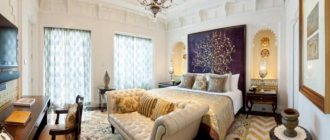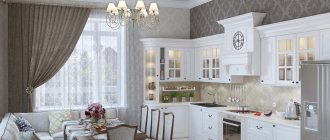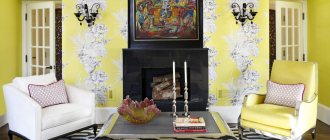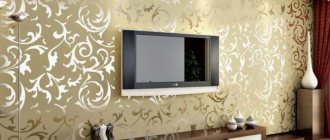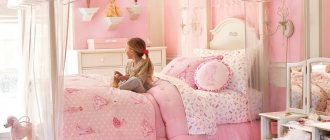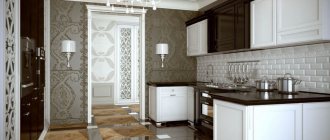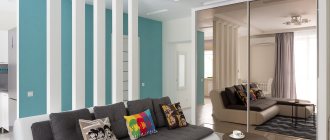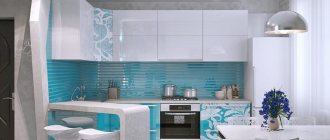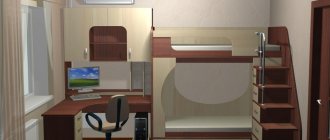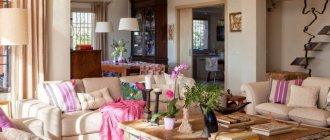Art Deco is a very popular, incredibly expressive, elegant, recognizable style that has long been loved by many modern designers. It always looks rich and elegant, giving pleasure to those contemplating this interior. Most often used to decorate hotels, expensive restaurants, halls where official receptions, weddings, and banquets are held. From the outside it seems that in such a room you can not only live and relax, but also make films and do photo shoots for memory. Read more about what Art Deco looks like in the interior of various rooms, how and where it originated, and its main features in the text of this article.
History of the style
The style originated at the beginning of the twentieth century in France, namely in Paris. By the 20s and 30s he had reached the peak of popularity. These were the post-war years of crisis, the Great Depression was gaining momentum, but by the 40s the style had already entered the international arena. It combined functional industrial with shades of African primitivism, the spirit of the Jazz Age with the rigor of neoclassicism, shiny metal with precious woods, and the color palette of Fauvism with black and white gradients.
Later, in some countries, Art Deco or Art Deco gave birth to the functionalism style, and at the same time the Art Nouveau style arose, embodying a new art. Art Deco had a noticeable influence on the architecture of buildings and interior design of the USSR during the Stalinist period - the 30-40s. At that time it was considered a “respectable style for the middle class”, and therefore was considered unacceptable for most Soviet people. Tourism and travel to exotic countries then became popular all over the world, and a fashion arose for various souvenirs and trophies brought from there.
Design options for a studio apartment in art deco style
A studio is an apartment in which not every finishing method can be used, but the basic ideas of art deco will come in very handy here. For example, designers suggest decorating a room in one color and texture range, making smooth transitions from one room to another. Such smoothness, firstly, visually expands the space, and secondly, it allows the use of various techniques and methods of applying basic stylistic ideas.
A studio apartment in the Art Deco style should serve as a standard of glamor and amaze with its splendor
So, for example, a youth studio apartment can be decorated in a black and white combination, and it is permissible to make the walls black. They will be effectively covered with a print in the form of white streaks, an outline of flowers, or text from a book in the form of a decorative panel.
An example of stylish decoration of a youth studio apartment in the art deco style
The second feature of the studio will be platforms and steps onto which you can “raise” the sleeping area, island work surface, sofa - this will be very stylish and will help contribute to the problem of space zoning. Bright accessories can complement the picture - crystal vases with fresh flowers, mirrors in large elegant silver frames, elegant metal sculptures.
To summarize, we can draw one conclusion - the art deco style is one of the most multifaceted and interesting styles in modern design, opening up an unlimited number of diverse ideas. Using them, you can turn your apartment into an elegant, spacious home that brings joy and pleasure to all household members.
Distinctive features
The main features of art deco:
- a clear pattern in everything;
- bold “broken” geometry, including ethnic ornaments;
- asymmetry, streamlining, tortuosity of lines;
- an abundance of halftones with rare inclusions of overly bright colors;
- the most expensive materials;
- pretentious luxury, the highest chic of design;
- stylized images of animals, the latest technology;
- mosaic of wood, glass, stones, stained glass, many mirrors;
- crystal, expensive dishes, outlandish souvenirs from different countries;
- an abundance of varnish, glitter, glamour.
In modern times, real bone figurines, terracotta figurines from Africa or American Indian tribes are often replaced with crafts from local designers, which makes the design a little cheaper, without compromising the overall appearance.
Materials, surface finishing methods
The materials used are mostly modern and expensive:
- ivory, rhinoceros, deer horn;
- rare types of wood - mahogany, rosewood, sequoia, bog oak;
- reptile skin – snake, crocodile;
- various metals - aluminum, brass, steel, silver;
- natural, less often artificial stone - granite, marble, onyx, travertine, labradorite, slate;
- ceramics, expensive wallpaper;
- plasterboard, ceiling tiles;
- transparent, frosted, colored glass.
The ceiling is whitewashed, made of plasterboard, including a multi-level one, and decorated with gypsum and polyurethane stucco. Plastic ceiling rosettes, baseboards, corner elements, moldings and half-columns on the walls can be gilded or bronzed. The walls themselves are decorated with decorative plasters, silk wallpaper with geometric patterns or heraldic patterns, African patterns, and oriental hieroglyphs.
The floor is usually made of parquet, combining several types of wood, from which complex patterns are laid out - with central symmetry for the entire room or small, repeating ones. Less often, floors are decorated with stone, since it is very cold, and mirror design is suitable for both the floor and the ceiling, walls, and any furniture. Interior doors are preferably double-leaf wooden, paneled or with an insert of patterned glass, stained glass windows depicting fantastic scenes of ancient myths.
Color palette used
The following color combinations are often used:
- gold with black;
- white with golden brown;
- white-green with purple-black;
- chocolate with ivory color;
- beige with noble purple;
- purple with emerald;
- antique azure with terracotta;
- bistre with pale yellow;
- sand with bronze;
- gold with wine red;
- wisteria with graphite black;
- chestnut with quartz gray.
Golden, brown, and beige shades are almost always used as a base, complemented by accessories with bright splashes of red, blue, green, and purple.
Color scheme of a one-room apartment in Art Deco style
Color in the Art Deco style plays an important role: it emphasizes the status of the interior. In addition to the fact that color schemes are based on the principle of contrast, a combination of tones that are similar in gamut is also acceptable. For example, for a luxury bedroom in the Art Deco style they use beige with gold or red. Both combinations are complemented by geometric patterns.
To decorate the living room or office area, they try to choose darker shades. The combination of chocolate and gold colors looks luxurious. The walls are decorated with natural, varnished wood, handmade furniture upholstered in luxury leather, expensive lamps with legs, and gilded interior details. You can choose another combination for this zone: dark purple and dark gray, diluting them with black and white.
When creating the interior of a one-room apartment in the Art Deco style, you can safely combine colors, for example, red and green. The main thing is to use a neutral color as a basis for a harmonious combination - black, gray or white. Bright colors are used only in the form of fragments.
Geometric patterns, stripes, and zigzags are mandatory for the Art Deco style.
Coordination of work
Most often you can find such figures:
- stripes of different widths - from thin to wide;
- a pattern of repeating trapezoids, rhombuses, rectangles and others;
- unusual patterns on curtains and drapes;
- prints inspired by the skins of exotic animals.
Lighting
The right light in art deco interiors is of no small importance, creating coziness and adding even more solemnity to the atmosphere. These are huge multi-arm chandeliers made of crystal and glass that softly diffuse the light. The smaller the room, the more lamps and fixtures should be used. This is especially true for “northern” rooms with small windows or those where there are no windows at all - dressing room, bathroom, hallway, corridor.
The walls are illuminated with the help of sconces, sometimes having overly elaborate shapes, floor lamps with large shades on an ornate carved wooden leg or with a base in the form of an ancient Greek statue. Floor lighting for this interior is unacceptable in any form - the light falls strictly from above, maximum from the side, but no less than from a height of one third of the distance from the floor to the ceiling.
The most incredible, large, luxurious chandeliers are suitable - with a large number of horns, complex geometry, gilding, in the form of a huge painted ball, etc. Miniature spotlights are allowed only in those rooms where, due to the small area, a full-fledged chandelier cannot fit.
Warm light is preferable - with its help the shapes of various decorative elements are more advantageously emphasized. The abundance of mirrors also visually “multiplies” the amount of lighting.
Room decor
Decorating the interior of an apartment in the art deco style requires a careful approach to the finishing of the walls, ceiling and floor. The walls in the room are designed to become a successful backdrop for exclusive furniture. Therefore, it is best to give preference to monochromatic solutions.
The following can be used to decorate the walls:
- liquid wallpaper or paintable wallpaper;
- textured plaster;
- a natural stone.
The choice of shade depends on the purpose of the room. For the bedroom, the best choice would be cream and beige colors. You can use a combination of black and white shades in the office. In living rooms, gilding, bright sapphire and emerald tones would be appropriate.
Art Deco interiors are characterized by glossy flooring. It makes the room more presentable and bright. In a modern interpretation, a self-leveling floor with a sealed pattern is most often used. Floors made of polished marble, glossy large ceramic tiles or parquet would also be appropriate.
The art deco style in the interior of the apartment will be holistic and complete with the right choice of ceiling covering. For such interiors, a good choice would be a chic ceiling with stucco or a multi-level tension structure with original lighting.
If the ceilings in the apartment are low, then it is best to choose glossy ceilings or additionally decorate them with mirror panels.
Furniture
All furniture has smooth lines and rounded corners. The materials used, in the vast majority of cases, are solid natural wood of valuable species, but sometimes even fiberboard, lined with veneer made from expensive wood, is allowed.
The main types of wood used for furniture in Art Deco interiors:
- rosewood;
- nut;
- oak;
- pink tree;
- maple;
- ash;
- palm tree.
Chromed, forged, inlaid, carved parts are also often used. Some pieces of furniture use glass, including frosted glass, stained glass, and ivory. Various types of leather are used to decorate upholstered furniture:
| traditional | veal, pork, sheep, goat, deer |
| exotic | snake, crocodile, fish, shark, elephant, zebra, lizard |
Many types of upholstery fabrics are used:
- dense jacquard;
- tapestry;
- velours;
- velvet;
- artificial leather;
- flock and others.
A lot of upholstered furniture is used for the art deco style - narrow sofas, couches, high beds, huge sofas, armchairs, soft chairs, poufs are present in all rooms. Furniture is often made to order, in single copies or limited editions. All furniture is made in one color, but individual elements can be made in a different color scheme to create several bright accents.
There is no need to give preference to overly massive pieces of furniture; if they are necessary, they should have separate elegant elements or decor - openwork carving, painting, inlay.
Distinctive features of the art deco style
Art Deco incorporated elements from many other movements: Art Nouveau, Empire, Pop Art and Kitsch. It appeared in modern times on the verge of the transition from classical styles to what was then considered modern. Even now it cannot be completely attributed to either modern or classical styles.
What makes it unique is the combination and level of saturation of these elements. If we usually say that the simpler the better, then in art deco it’s the other way around. Complexity and deliberate luxury are our everything. But it is achieved not at the expense of flowers; their set is just limited.
Remember the main thing: Art Deco style is chosen to impress others (wow effect), but it is not the most practical design style to live in.
The strongest difference between Art Deco and other styles is mixed geometry. Modern styles use correct geometry with straight lines and angles, and there is a strict taboo on any curved lines in the decoration (this is compensated by smooth lines in upholstered furniture). In classical styles, on the contrary, the decoration has a bunch of smooth shapes: rounded baseboards and stucco molding, carved furniture, curlicue patterns on the wallpaper.
The Art Deco style in the interior combines the straight lines of modern styles and patterns with curves from classical styles. And together with a large number of objects, all the lines are mixed as in a painting, and the eye does not stop at one thing, but sees the whole picture.
In art deco there are no main accents; the interior is perceived holistically as a painting.
Textile design
An abundance of various textiles is usually present in the stylistic design of Art Deco. The fabrics chosen are plain, with zigzag, geometric patterns, colored stripes or checks; zebra, leopard, and snake prints are also suitable. Damask patterns, houndstooth patterns, and meanders are also popular.
The most commonly used fabrics are:
- velvet;
- cashmere;
- velveteen;
- tapestry;
- coarse woolen fabrics;
- silk.
The interior features luxurious carpets, heavy curtains, tapestries, cross-stitched paintings, pillows embroidered with gold patterns, and canopies with floral patterns framing the bed or dressing table. Soft blankets are made double-sided, from wool or faux fur.
Draperies on the walls also have a place, present at the head of beds or in the form of movable elements dividing a large space or studio apartment. Coffers of various sizes are present in the interiors of almost all rooms; they can be made in plain or variegated colors. Thick patterned curtains with a printed pattern are complemented by tulle with an abundance of flounces. The edges of the carpets are complemented by stripes of meanders or Chinese characters.
Accessories, decor
The decorative design is very diverse, most often the following items and details are present in abundance:
- figurines, animal figures;
- luxurious fans, candles;
- mirrors on any surfaces;
- forged gratings, including space zoning;
- paintings in carved frames - the larger the better;
- decorative ceramic and glassware;
- souvenir bottles with expensive alcohol;
- pearls, natural bone, turtle shells;
- dry bouquets, floral panels.
Among the paintings, in the descriptions of famous interiors, there are works by Klimt, Vasnetsov, Delorme, Serebryakova, Cassandre, Dupas and many others.
Among the artistic motifs of sculptures and paintings there are:
- geometric shapes - circles, squares, zigzags, polygons, ovals, black and white piano keys, steps;
- oriental motifs - ziggurats, pyramids, sphinxes, frescoes;
- plant and animal patterns and shapes - sakura branches, bonsai tree, leaves of exotic trees, fantastic animals, mythological characters;
- anthropomorphic subjects - Arabs, Indians, graceful figures of women.
In a too cramped room, you shouldn’t place too much decor; just focus on a few contrasting elements - the room will look cluttered.
Room interiors
This style is not widespread, but it is widely known everywhere. Any hints of asceticism or minimalism in the interior are alien to him.
The following are used in abundance here:
- carpets, curtains, all kinds of draperies;
- decorative fountains, podiums, arches;
- reproductions of paintings in the Cubist style, famous American graphic artists;
- sculptures made of ebony wood, ceramics;
- floor vases, palm trees in pots.
In the art deco style it is easy to combine objects that are difficult to fit into the framework of one style. There are always many elements involved, and the overall picture does not have to be conceptual.
It is unlikely that it will be possible to completely recreate the interior of a “palace” of the last century in a small apartment, but the use of individual elements and attributes of the style will make it possible to make at least a miniature likeness.
Bedroom
A light, tall chest of drawers, seemingly “bloated” on the sides, with curly handles on the drawer fronts looks good. Illumination on both sides of the bed above the bedside tables is carried out using a sophisticated sconce shape, with shades in the form of flowers that gently diffuse the light. Intricate interweaving patterns on the wallpaper will enliven the room, and a decorative or electric fireplace will create a feeling of warmth and comfort.
A bedroom looks ideal where one or two, maximum three groups of objects have the same pattern - the carpet is combined with curtains, ceiling tiles with wallpaper, pillows on the bed with upholstery and patterns on the parquet floor. A double bed with a patterned canopy and valance is in harmony with a sophisticated desk and dressing table, above which there is a round mirror framed in the shape of a sun. The dressing area is separated by a patterned screen.
If the wall opposite the head of the bed is decorated with an intricate labyrinth, which is often an attribute of the Art Deco style, then it will be pleasant to look at it while meditating before bed.
Living room
A huge leather sofa with a dome-shaped back will become the compositional center of an Art Deco interior. A medium-sized chest of drawers made of rosewood or palm wood, coated with a thick layer of varnish, a low “oriental” table, chairs or ottomans decorated with zebra or leopard prints will complement the interior. The middle of the ceiling will be decorated with a large crystal chandelier, and the corners will be decorated with floor lamps or sconces, made in the same luxurious style. On the floor in the very center of the room there will be a Japanese-style bamboo mat woven with gold threads or a fluffy carpet with folk ornaments.
A marble console that acts as a stand for a flat-screen TV would also be appropriate. In the most spacious rooms with high ceilings and good acoustics, they place a grand piano on a podium, and occasionally even a full-fledged drum set or a DJ console with all the accompanying paraphernalia.
The living room space may well look like a showroom, where many different objects are examined for hours, each time finding new details.
Children's
The furniture in the nursery, like other Art Deco rooms, does not have sharp corners. A warm, soft wool rug will allow children to play on the floor on long winter evenings. You should not overload this room with an abundance of fragile decor, especially if the children are small - safety comes first here. Stucco molding on the ceiling, a high-mounted lamp made of unbreakable glass, a canopy over the crib, many trunks for storing toys, a couple of pictures in carved frames - this is enough to clearly indicate the style.
It’s easy to decorate a room yourself, together with your child, by using a stencil to depict colored damask monograms and geometric shapes on the walls, lampshades, and window frames. The rising sun is often depicted above the headboard, in harmony with the same embroidery on the backs of soft chairs or sofa cushions.
The following shades are preferred here:
- pink, blue;
- gold, silver;
- violet, beige;
- light yellow, spring green;
- linen, bluish-gray.
A miniature dressing table is perfect for this style if the room belongs to a girl. A comfortable functional table with a suitable style is also made for the boy.
Kitchen
Light marble walls are often present in kitchens designed in this style. It looks most beautiful when the room has an insulated balcony, a spacious loggia or a bay window - some of the window glass is then decorated with colored stained glass, which allows even the most “pale” interior to sparkle with new colors.
A black and white checkerboard ceramic tile floor would be very appropriate here. It can be combined with a kitchen apron of the same color, sharply contrasting with a set that is light or overly bright. Curved worktops, a rounded bar counter with matching chairs will fit perfectly into the overall Art Deco style. The facades of the furniture must be glossy, the doors have engraved glass or stained glass, all household kitchen appliances are preferably built-in. The dining table has a luxurious tablecloth and the chairs around it are upholstered to match.
For a spacious kitchen, an island set is quite suitable, and space along the walls will be occupied by soft sofas and all kinds of decor.
Hallway
The walls of a long corridor are decorated with lamps stylized as oil lamps or candles, located on both sides, and a carpet is laid on the floor, as in a real palace. Plastic molding along the ceiling also wouldn't hurt.
A large mirror in a wooden or forged frame with gilding emphasizes the high cost of the interior from the threshold. Graphics will come in handy here: wallpaper with damask patterns, floor tiles or ottomans with the same pattern. The legs of the few hallway furnishings are often wrapped in fish skin. In the square hallway they hang a chandelier shaped like an inverted dome.
For a narrow corridor or cramped hall, choose the lightest possible wall design with a minimum of contrasts.
Bathroom
Walls decorated with frescoes a la Egypt will add uniqueness to this room, creating interesting accents. The same motifs are duplicated on towels and the curtain over the bathtub. Stone cladding, coupled with spot lighting, will add even more solidity to the interior. Monochrome porcelain tiles on the floor of a shared or separate bathroom, especially contrasting with the color of the walls, give a hint of the Renaissance, and an abundance of mirrors will make the room light and spacious. The golden mosaic designating individual areas of the room also looks great.
If the floor is made entirely of stone, it is advisable to equip it with special heating, otherwise it will be cold for bare feet to step on it even if there is a carpet.
Furniture and accessories
Furniture embodying the Art Deco style in the interior is selected in the same style of luxury and comfort. Often, such interior items are quite original and minimize the need for additional decor due to their non-trivial exterior. Shapes and bending are used, both straight and smooth, curved. Most often, a frame made of dark wood is complemented by light or printed upholstery. The dining room and kitchen in the Art Deco style are complemented by a furniture set with curly or curved legs. Tables often have glass inserts, and chairs are upholstered in luxurious velvet.
Do not overuse decor - curly shapes of interior items, glossy surfaces and fancy lighting fixtures can already create a solid image of the Art Deco style in the interior. You can hang a panel with photographs or a designer gold-plated watch on the wall. Floor vases or sculptures will add grace, and a couple of unpretentious plants in pots will enliven the space, the main thing is to ensure the uniformity of the stylistic design.
IMPORTANT: if you decide to decorate a wall or any other surface with mirror inserts or glossy panels, be prepared for frequent cleaning, especially if there are children in the house.
Photo of art deco style in the interior of the apartment.
Credit: @
Light furniture against the background of emerald walls.
Credit: @
The richness of the furnishings in the design of the room.
